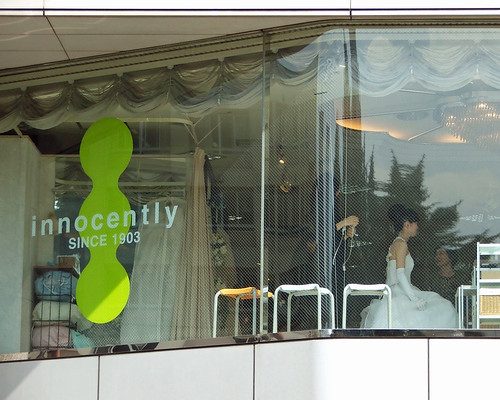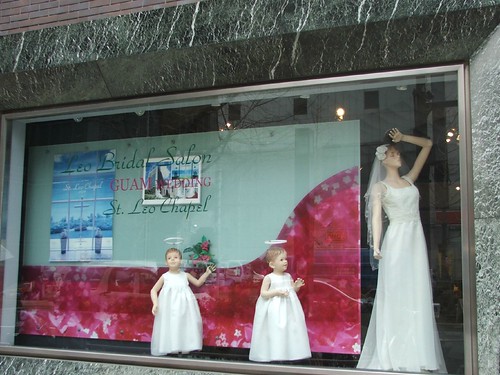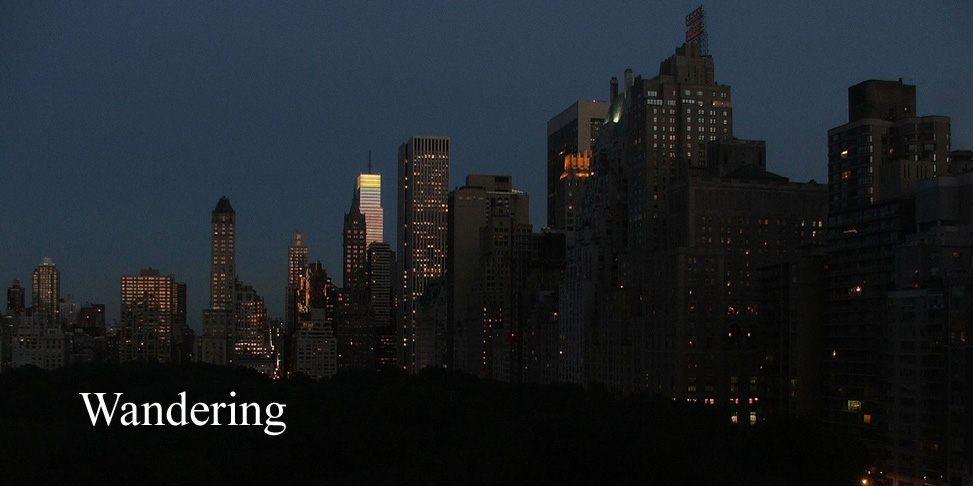
Opera Australia has opened a new production of Mozart's Cosi Fan Tutte directed by Jim Sharman. "It's not in an airport lounge this time" a I heard someone explain to her companion " though that is a good setting as they are soldiers going to war". I fear this was a confusion with the recent production of Abduction from the Seraglio; but it shows the risk a company runs locating shows where they don't belong.
This production is located in a Japanese wedding: "I don't understand why the bride is there", someone else remarked. The program notes don't explain it either, but I will try.
It's not a Shinto wedding with the bride and groom staring at the camera from their ancient costumes, but one of those weddings that happen on Guam or at the glass walled Crystal Wedding Chapel in Port Douglas. The popularity of these ceremonies is one of the mysteries Japan presents to outsiders. The tradition behind the elaborate dressing up, chauffer driven limousines and wedding formalities seems completely detached from the participants but they find great enjoyment in it nevertheless.

The plot of Cosi, is famously absurd. The much adored fiancés of two sisters are shipped off to fight a war at short notice, but return immediately so convincingly disguised as Albanians that each is able to seduce the other's girlfriend. It's best seen as a fantasy, and this production successfully creates one by staging the opera as an entertainment performed at the Japanese wedding. ( If Mozart had known of this scheme he would have allowed a little more time for setting the scene, I think.)
So we have a comedy wrapped in a fantasy inside a daydream, or something like that. Anyway, this device works as a way of overcoming the inherent improbability of the plot and oddly enough makes many of the incidents and interactions more believable and intense than might be possible in a production which attempts realism. Admittedly, the OA production which this replaces did involve the idea of a performance, but it didn't realise it nearly as well.
There is also an irony involved in a story of deception and romantic betrayal told in the framework of an idealised, if fanciful, wedding ritual.
There is a deep, mainly white, single purpose set, which seemed a little too big at times for a work which has only a small chorus and many scenes with only one or two participants. It does, however allow for a lot of movement, and this enlivens a piece which is potentially too static. The liveliness is reflected in the marvellous, frequently changed, brightly coloured costumes. The exuberantly coloured camouflaged greatcoats would maybe provide some cover in sideshow alley, but nowhere else.
It goes without saying that without the music, this story would be of little interest. But too much can be, and is made of it. I don't think we enjoy it because it demonstrates "profound human truths"; or as an embodiment of Enlightenment thought. The story gives Mozart many opportunities, and the score incorporates a remarkable range of moods, situations and colour. It's magic because it can't be conveyed in words, but the best description I have found is the Cosi chapter of David Cairns' Mozart and His Operas.
In some recordings, the youthful exuberance and emotion of Cosi is lost because the singers, however excellent, sound too old. In this production, Opera Australia has found a cast of young but sufficiently experienced artists who sing well individually and blend together so well in the ensemble pieces.
I enjoyed all the performances: Jose Carbo is an active Don Alfonso, more cynic than philosopher. Tiffany Speight as Despina takes advantage of the scope offered in this production to give a more interesting performance than was possible in the 2006 production by Victorian Opera which only just became airborne.
Henry Choo has sung major roles with OA for some years, beginning as a light tenor in productions of Elixir of Love and Lakme. I had some concerns that as he moved to more dramatic roles he could be progressing too fast for the development of his voice, but he was perfect here; more convincing than his Don Ottavio in Don Giovanni only a year ago.
Rachelle Durkin is a wonderful artist and her portrayal of Fiordiligi ranged from girlish delight to intense emotion. This combination was most convincing. Older singers can bring dramatic intensity but can't be very convincing in the lighter moments.
Sian Pendry, Dorabella , and Shane Lowrencev, Guglielmo, are both singers who have emerged in stages from the OA chorus. Last year I mentioned Sian Pendry's fine performance in the MSO Flying Dutchman concert and this performance confirmed my opinion. It is difficult to judge the quality of singers in minor roles. Their ability and potential must be clear to the music staff and management when they are first selected, but the audience must wait for the opportunity for their talent to fully emerge in performance.
I was surprised how suited Shane Lowrencev was to a lyric role as he has been cast more as traditional bass, most recently as Polyphemus in Acis and Galatea, a part more suited to an older and more resonant bass baritone. It was a pleasure to hear him in full flight for the first time.





1 comment:
Thanks for the review!
We have just added our third video installment to Opera Australia's YouTube channel. This time hear from our costume designer Gabriela Tylesova: http://www.youtube.com/watch?v=KjTobklKIBo
Best,
Aussie Cosi
Post a Comment